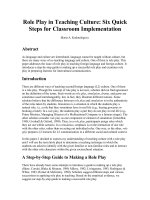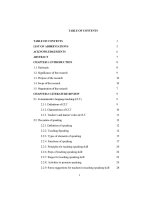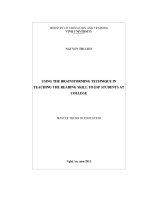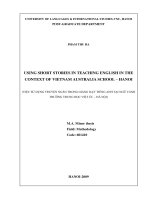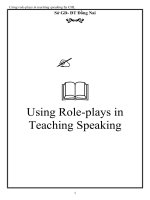Using role play in teaching english pseaking skill to 11th graders
Bạn đang xem bản rút gọn của tài liệu. Xem và tải ngay bản đầy đủ của tài liệu tại đây (2.85 MB, 121 trang )
TABLE OF CONTENTS
TABLE OF CONTENTS
1
LIST OF ABBREVIATIONS
5
ACKNOWLEDGEMENTS
6
ABSTRACT
7
CHAPTER 1: INTRODUCTION
8
1.1. Rationale
8
1.2. Significance of the research
9
1.3. Purpose of the research
10
1.4. Scope of the research
10
1.5. Organization of the research
7
CHAPTER 2: LITERATURE REVIEW
9
2.1. Communicative language teaching (CLT)
9
2.1.1. Definitions of CLT
9
2.1.2. Characteristics of CLT
10
2.1.3. Teacher’s and learner’s roles in CLT
11
2.2. The nature of speaking
12
2.2.1. Definition of speaking
12
2.2.2. Teaching Speaking
12
2.2.3. Types of elements of speaking
15
2.2.4. Functions of speaking
17
2.2.5. Principles for teaching speaking skill
20
2.2.6. Steps of teaching speaking skill
22
2.2.7. Stages for teaching speaking skill
23
2.2.8. Activities to promote speaking
24
2.2.9. Some suggestions for teachers in teaching speaking skill
28
1
2.3. Role play
29
2.3.1. Definition of speaking
29
2.3.2. Benefits of using role play
33
2.3.3. Types and procedures in using role play activity
34
2.3.4. How to use role play activities in the classroom
36
2.3.5. Significance of role play in teaching speaking
38
CHAPTER 3: RESEARCH METHODOLOGY
40
3.1. Subjects of the research
40
3.2. Place and time of study
40
3.3. Research questions
40
3.4. Population and Sampling
41
3.5. Data collection
41
3.5.1. The questionnaires
41
3.5.2. Pilot teaching
42
3.5.3. Interviews
42
3.6. Data analysis
43
3.7. Research procedures
43
CHAPTER 4: FINDINGS AND DISCUSSION
44
4.1. Overview
44
4.2. Findings
44
4.2.1. Participants
44
4.2.2. Students’awareness towards four skills and speaking skill in learning
English
45
4.2.3. Factors related to students’ interest in speaking lessons
48
4.2.4. Students’ difficulties in speaking lessons
49
4.2.5. Students’ opinion about the frequency of teacher’s role play activities in
teaching speaking skill.
50
2
4.2.6. Students’ attitude towards role play activity
50
4.2.7. Students’ feedbacks to the implementation of CAs
51
4.2.8. Benefits of learning English speaking skill lessons use
role play activities
52
4.2.9. Teachers’ opinion about speaking skills
53
4.2.10. Teachers’ perception about the use of CAs in teaching
speaking skills
55
4.2.11. Teachers’ role in designing and managing RPs in classroom
58
4.2.12. Teachers’ implementation of RPs
59
4.2.13. Benefits of using RPs in teaching English speaking skill to
11th graders
60
4.2.14. Difficulties of teachers encounter when conducting RPs in teaching
speaking skill
61
4.3. Discussion- Discussion of the result of the findings
61
4.4. Summary
68
CHAPTER 5: CONCLUSION AND SUGGESTION
69
5.1. Conclusion
69
5.2. Implications
71
5.3. Suggested Teaching Techniques
72
5.4. Limication
72
5.5. Suggested further research
73
REFERENCES
74
APPENDICES
76
1. Place and Time of Study
76
2. Pilot teaching
82
2.1. Activities and procedures
82
2.2. Students’ Feedback
87
3
2.3. Teachers’ evaluation on the lesson
88
2.4. The researcher’s comment
89
Appendix 1: Questionnaire for teachers
91
Appendix 2a: Questionnaire for students (English version)
95
Appendix 2b: Questionnaire for students ( Vietnamese version)
99
Appendix 3: Questions for teachers interview
103
Appendix 4: Observation Sheet
104
Appendix 5a: Students’ feedback to pilot teaching ( English version)
105
Appendix 5b: Students’ Feedback to Pilot Teaching (Vietnamese version) 106
Appendix 6: Teachers’ Feedback to Pilot Teaching
4
107
LIST OF ABBREVIATIONS
CAs : Communicative Activities
CLT : Communicative Language Teaching
RPs
: Role Play Activities
C1
: Class 1
C2
: Class 2
Q1
: Questionnaire Number One
Q2
: Questionnaire Number Two
Ss
: Students
S1
: Student 1
S2
: Student 2
T
: Teacher
%
: percent
5
ACKNOWLEDGEMENTS
For the completion of
this thesis, I have received great assistance and
support from my teachers, colleagues, students and my family.
First of all, I would like to express my deepest gratitude to my supervisor,
Mr Tran Ba Tien, for his enormously helpful advice and kind guidance throughout
this study.
I am also grateful to all lecturers and the staff of the Department of
Postgraduate studies, Foreign Languages Department, Vinh university for their
useful lectures and guidance during my study at the institution.
My sincere thanks are due to all the colleagues and the students of the 11 th
form at Nam Dan 1 High School for their cooperation in giving me valuable
information.
Last but not least, I would like to acknowledge my debt to my family for
their encouragement, enthusiasm and whole-hearted support.
6
ABSTRACT
It is undeniable that English has become more and more important in any
society. Being aware of the importance of English as well as the necessity of
developing the learners’ communicative competence, the new textbook has been
applied with some considerable changes in the context and methodology in the 11 th
form. This book aims at improving students’ communicative skills concerning
speaking lessons through using role play activities. In order to investigate typical
difficulties in teaching speaking skill for the 11 th form students after such a in
syllabus, this study was carried out.
Before presenting the study, the study carried out the surveys, interviews
both teachers and students at NamDan 1 high school. Then the study analysed the
result of surveys, the result of interviews and the questionares and the study also
proved helpulness of using role play activities in teaching English speaking skill to
the 11th graders at NamDan 1 high school.
This study believes that the role play is very important in teaching English
speaking skill because it gives students an opporunity to practice communicating
different contexts and diffirent roles. It also allows students to be creative and put
them in order person’s place for a while.
The study shows that the use of role play speaking activities more enjoyable
and interesting. Role play activities help shy students by providing a mast. In
addition, using role play in teaching English speaking skill makes the world of
classroom is broaden to include the outside world and students more motivated in
learning easier to understand the lessons.
In the course of fulfilling this study, the research the data from obtained two
kinds of data: the questionares for teachers and students; the result of the research
period before and after using role play in English speaking lessons.
7
CHAPTER 1
INTRODUCTION
1.1. RATIONALE
Nowadays, English is an international language and has been widely used in
many countries in the world. Almost people from many different countries around
the world use it to communicate. The area of English has always become a special
interest. It’s because of the importance of English in any scope of our lives.
In Vietnam, English is also considered the most important foreign language
and taught as a compusolry subject in most schools throughout the country. It has
also become an important need of the Vietnamese as a means of communication.
There have been many changes in English teaching in order to meet the need. One
of the changes is related to new English language teaching syllabus and new
textbooks, which have been used at high schools since 2006. The new textbook
changes from grammar and vocabulary to skills- listening, speaking, reading,
writing.
In the international relationship, English speaking ability is very important to
be able to participate in the wider world of work. The speaking skill is measured in
terms of the ability to carry out a conversation in the language . This reality makes
teachers and parents think that speaking ability should be mastered by students and
children.
Based on the reasons above, in recent years, English language teaching has
focused on teaching the English language rather than teach about the English
language. The emphasis is not only on linguistic of the language learners but also
on the development of learners’ communicative ability.
In learning speaking skill, most students often meet some problems. The first
reason their native language causes them difficult to use the foreign language. The
second reason is because of motivation lack to practise it in communication. Some
students are afraid to join in the conversation.
8
Role play is very important in teaching speaking skill because it gives
students an opporunity to practice communicating different contexts and different
roles. It also allows students to be creative and put them in other person’s place for
a while. This helps students to develop their communicative English .
1.2. SIGNIFICANCE OF THE RESEARCH
I believe that the analysis of role-play can benefit English teachers, Ministry
of Education and Training, scholars, and students in many aspects. For English
teachers, I hope that the English teachers in Vietnam could adopt role-play as
one of the teaching methods. The finding of this study provides an insight into
role -play and helps students improve their speaking skill. Teachers may also
improve students’ perception of learning speaking.
One of the goals in learning a second language is to have good speaking
ability. Role play activities can help learners improve it. Miller (1990) claims
“communication instructors should be wary of the general ability of the role pla
activities in the classroom” (Miller, 1990, p.21)
Role-play not only serves as a useful source for students to practice
speaking daily English conversation, but also helps them improve their style of
speaking skill.
For students, I expects students to be aware that they should improve the four
skills equally when learning English. No matter which skill in English is more
emphasized in the Basic Competence Test (BCT)- the main examination for
junior high school students to enter senior high schools, students should learn and
study these four skills at the same time. In addition, students should not only
focus on the BCT, but they should also know that learning a second language will
help them become more competitive.
For all these reasons, it is necessary to use role play in teaching speaking skill
for the students of the eleventh grade at Nam Dan 1 high school. I also want to know
the advantages and the problems encountered by teachers and learners in using period
9
role play in speaking lesson. I hope that the study will help the learners to improve
their English communication ability.
1.3. AIMS OF THE RESEARCH
The aims of study is to know whether the result of teaching speaking for
students in the eleventh grade at Nam Dan 1 high school by using role play better
or not through comparing the students’ scores before and after using role play
technique.
How to teach students communicatively speaking skill with using Role Play
seems to be a challenge to English teachers not only in my school but also at the
other High schools. Therefore this paper is written to investigate the reality of
teaching speaking skill at some upper secondary schools in Nghe An. Also, this
study intended to explore the application of Communicative Activities (CAs) to
develop the quality of teaching and learning English as well as to improve the
language interaction of students in speaking lessons. Finally, it seeks to find out, to
what extent, these CAs have influence on students’ study achievements.
Hopefully, through the study, can provide some suggestions to apply CAs
effectively which would be beneficial for teachers in using role play in teaching
speaking skill at High schools.
1.4. SCOPE OF THE STUDY
Communicative Language Teaching (CLT) using role play has now
improved speaking skill in teaching and learning English. In order to help students
to communicate effectively in speaking class, teachers can conduct various Role
Play Activities (RPAs). Many researchers as well as teachers have drawn their
attention to the role of RPAs in teaching English speaking skills. However, due to
the limitation of time and knowledge, the researcher does not have the ambition to
cover all the aspects related to CLT in teaching and learning speaking such as the
difficulties when adapting CLT to speaking classes at High schools, teaching
material design and adaptation. The study is restricted to investigating the RPAs
10
used to motivate the 11th graders in speaking lessons at Nam Dan1 High school,
Nam Dan, Nghe An.
1.5. ORGANIZATION OF THE STUDY
Beside the abstract, bibliography and appendices, the study is divided into
three chapters as follows :
Chapter 1, The Introduction presents the rationales for the research,
Significance of the study, Aims of the research, Research questions, Population and
Sampling, Data collection, scope of the study, orgnization of the study.
Chapter 2, “Literature Review”, a brief summary of previous studies related
to the research is offered as a basis for the study. The main theoretical background
of this paper is based on the opinions of researchers like Hayriye Kayi (2006),
Harmer (1984), Paul Procter ( 1996) , dealing with the nature of teaching speaking
in foreign language such as the definitions of speaking, Activities to promote
speaking, Some suggestions for teachers in Teaching Speaking Skill Lessons,
Principles of teaching speaking Definition of Role play, Types and Procedures in
using role play and the roles of teachers and students in English speaking skill
lessons, interactions in language classrooms are clarified. Furthermore, factors
influencing students’ success in foreign language learning through using Role Play
such as motivations, attitudes are also discussed in this research.
Chapter 3, “Research Methodology”, addresses the subjects, and presents the
methods and procedures used to implement the study.
Chapter 4, “Findings and Discussion”, describes the reality of using Role
play in teaching English speaking skill at NamDan1 High school in Nam Dan, Nghe
An, difficulties the students and teachers encounter in speaking lessons, the
discussion of research questions and the solutions to the teaching speaking at
NamDan1High school and the other High schools in Nghe An. The data collected
from the survey are quantitatively and qualitatively analyzed.
11
Chapter 5, “Conclusion and Suggestion” conveys an overall conclusion. It
also suggests some solutions of using RPAs effectively to the teachers and students
for overcoming the existing difficulties and improving the quality of teaching and
learning English speaking skill at upper secondary schools. The last part is the
Conclusion of the study, which summarises the study, states the limitations of the study
and recommendation for further research are also mentioned in this chapter.
12
CHAPTER 2
LITERATURE REVIEW
In chapter 2, the first, the writer will provide a brief summary of previous
studies related to the research as a basis for the study.
The second, the main theoretical background of this study is based on the
opinions of researchers like Hayriye Kayi (2006), Harmer (1984), Paul Procter
(1996), dealing with the nature of teaching speaking in foreign language such as the
definitions of speaking, activities to promote speaking, Some suggestions for
teachers in Teaching Speaking
Skill Lessons, Principles of teaching speaking
Definition of Role play, Types and Procedures in using role play and the roles of
teachers and students in English speaking skill lessons, interactions in language
classrooms are clarified. Furthermore, factors influencing students’ success in
foreign language learning through using Role Play such as motivations, attitudes
are also discussed in this research.
2.1. COMMUNICATIVE LANGUAGE TEACHING (CLT)
2.1.1. Definitions of CLT
Richards defines that CLT can be understood as a set of principles about the
goal of language teaching, how learners learn a language, the kind of classroom
activities that best facilitate learning, and the role of teachers and learners in the
classroom.
The term CLT, in fact, covers a variety of approaches that all focus on
helping learners to communicate meaningfully in a target language rather than a
single methodology. These approaches parade under the general label
“communicative”, all of which characterize language teaching as the development
of communicative skills (Nunan, 1991: 78). CLT sets its goal to teach the learners
the communicative competence and this approach does a lot to expand on the goal
of creating communicative competence compared to earlier method that focused on
13
the same objective. Teaching students how to use the language can be seen as
important as learning the language itself.
According to Brown “We are exploring pedagogical means for ‘real life’
communication in the classroom” and “We are concerned with how to facilitate
lifelong language learning among our students, not just with the immediate
classroom task” ( 1994: 77)
There are many interpretations of what CLT actually means and involves.
However there are still some misconceptions about CLT. “Many teachers of
English believe that CLT means not teaching grammar, or CLT means teaching
only speaking not writing, listening and reading” (Thompson, 1996). As a result,
this approach may be applied inappropriately.
Although the various definitions of CLT have been offered, all of these also
claim that the goal of teaching language is to develop learners’ communicative
competence which involves the ability to use the language appropriately to a social
context. These components can be seen as linguistic competence, sociolinguistic
competence, discourse competence, and strategic competence. In order to help
readers see what CLT means deeply and completely, some characteristics of CLT
would be addressed in the next section.
2.1.2. Characteristics of CLT
Four interconnected characteristics of CLT were offered by Brown (2000:
266) as follows:
- Classroom goals focus on all of the components of communicative competence
and not restricted to grammatical or linguistic competence.
- Language techniques are designed to engage learners in the pragmatic, authentic,
functional use of language for meaningful purposes. Organizational language forms
are not the central focus but rather aspects of language that enable the learner to
accomplish those purposes.
14
- Fluency and accuracy are seen as complementary principles underlying
communicative techniques. At times fluency may have to take on more importance
than accuracy in order to keep learners meaningfully engaged in language use.
- In the communicative classroom, students ultimately have to use the language,
productively and receptively, in unrehearsed contexts.
Sharing the same view, Nunan (1991: 279) also proposed five common
characteristics of CLT classrooms:
- An emphasis on learning to communicate through interaction in the target
language.
- The introduction of authentic texts into the learning situation.
- The provision of opportunities for learners to focus, not only on language but also
on the learning process itself.
- An enhancement of the learner’s own personal experiences as important
contributing elements to classroom learning.
- An attempt to link classroom language learning to language activation outside the
classroom.
2.1.3. Teacher’s and Learner’s Roles in CLT
a. Teacher’s Roles
CLT focuses on the importance of providing learners with activities which
give them the opportunity to use target language for their communicative purpose.
The type of classroom activities in CLT, therefore, requires teachers' new roles in
the classroom. Rather than being a model for correct speech, teachers have
responsibility to facilitate the communication among learners, they establish the
CAs in order to supply their students the chance to share their ideas and opinions on
a regular basis. In another word, this involves students in realistic communication.
According to Harmer (2001: 56-57), teachers performs multi-roles which
vary for different activities such as controller, organizer, prompter, counselor,
informants, assessor, participant, observer, tutor, performer, and as a resource.
15
Additionally, some other authors view teacher’s role as facilitator (Nunan,
1991), need analyst (Richards and Rogers, 1994), instructor, co-communicator
(Littlewood, 1991), researcher (Breen and Candlin, 1980), manager (Freeman,
1986).
Obviously, teachers play many new roles in CLT. However, it depends on
the teaching context in which some roles are more prominent than others.
a. Learner’s Roles
A great deal of use of authentic language is implied in CLT. CLT employs
learner-centered approach in which students are communicators. It is supposed that
learners now participate in classroom activities that base on a cooperative rather
than individualistic approach to learning. They should feel comfortable with
listening to their peer in pair work or group work tasks.
Furthermore, Breen and Cardlin (1980: 110) describe learner’s role in CLT
as “negotiator – between the self and learning process and the object of learning –
emerges from and interacts with the role of joint negotiator within the group and
within the classroom procedures and activities which the group undertakes”.
In order to achieve the aim of communication successfully, learners are
supposed to work as communicators and negotiators. They are also claimed to take
on more responsible for their own learning.
2.2. THE NATURE OF SPEAKING
The theoretical background of the study will be fully developed later in the
thesis. It discusses about speaking, definitionof speaking, teaching speaking and
guiding teachers in teaching speaking. In addition, It also discusses about role play,
definition of role play, types and procedures in using role play and significance of
role paly in teaching speaking skill.
2.2.1. Definition of speaking:
16
According to Oxford Advanced Dictionary, speaking is “ to express or
communicate opinions, feeling, ideas, etc, by or as talking and it involves the
activities in the part of the speaker as psychological, physiological (articulator) and
physical (acoustic) stages.”
Theodore Huebner said that “Language is essentially speech, and speech is
basically communiction by sounds”. According to him, speaking is a skill used by
someone in daily life communication whether at school or outside. The skill is
acquired by much repetition. It is primarily a neuromuscular and not an intellectual
process. It consists of competence in sending and receiving messages.
From the definitions above, it can be said that speaking is expressing
opinions, ideas or feeling to others by using sounds or words of articulation in order
to inform, to persuade and to entertain that can be studied by using teaching and
learning methodologies.
2.2.2. Teaching Speaking
Speaking is one of four skills of second language teaching and learning. It is
not easy to students at high school to communicate each other in English smoothly.
Today, the target of teaching speaking
should improve
students’
communicative ability. Because, only in that way, students can express themselves
and study how to follow the social and cultural rules appropriate in each
communicative situation.
1. What is Teaching Speaking?
Teaching Speaking is to teach English language learners to:
- How to use words and sentences stress, intonation patterns and the rhythm
of the second language.
- Produre the English speech sounds and sounds patterns.
- Select appropriate words and sentences according to the proper social
setting, situation, audience and subject matter.
- Organize their thoughts in a meaningful and logical sequence.
17
- Use language as a means of expressing values and judgments.
- Use the language quickly and confidently with few unnatural pauses which
is called fluency. ( Hayriye Kayi, Teaching Speaking: Activities to Promote
Speaking in a Second Language, The Internet TESL Journal, Vol.XII, No.11,
November 2006)
.2. How is Teaching Speaking?
The first thing to keep in mind is that when we are helping our language
students learn to speak English, we are not actually teaching them to speak. Unless
they are infants, they already know how to do that. What we are really helping
them with falls into three categories:
- improving fluency (speaking smoothly)
- improving pronunciation (saying words properly)
- improving enunciation (Saying words/phrases clearly - I think this includes
word and sentence intonation)
Speaking is about using our mouth and vocal cords to make sounds that
people understand as language. It certainly involves other elements like grammar
and vocabulary, but they aren't the core of it.
a. Improving Fluency
Fluency comes from practice - plain and simple. However it needs to be
practice that involves extended use of the language and use of extended sentences.
You can not build fluency by repeating single words or short phrases. Fluency at its
heart relates to being able to speak for longer periods of time in a smooth way.
Broadly speaking, here are a few things that can help build fluency:
speeches or presentations
group discussions
role plays
negotiations and debates
interviews and meetings
18
chatting in small groups
b. Improving Pronunciation
Pronunciation is the ability to say words properly with the correct sounds in
the correct places. This is a skill that can take a very long time to develop, but with
consistent work and practice, it can be done. There are two keys to proper
pronunciation 1) native speaker input and 2) speaking by the learner with native
speakers. However, practice and lessons that target specific trouble areas can make
a huge difference in a student's ability to deal with issues in pronunciation.
working on specific vowels
working on trouble consonants (e.g. th for French speakers)
working on understanding movement and location of mouth and tongue
when making sounds.
c. Improving Enunciation
Enunciation is speaking clearly - perhaps better understood by its opposite
which is mumbling or slurring words. Enunciation is a very important aspect of
speaking in that poor enunciation can make someone almost impossible to
understand. Again improvements in enunciation come from exposure to native
speakers, and plenty of natural practice. Of course focused work targeting problem
areas can help a great deal as well. Things that can be done to help with
enunciation include:
focused work on trouble word combinations
working on reductions (want to –> wanna)
working on sentence level stress points
working on word level stress points (e.g. differences between noun/verb
forms of same word record/record)
working on sentence level intonation patterns
There are literally hundreds of different activities that
can used in different
situations. There isn't one right way, or even one right sequence. Just be sure to
19
give students plenty of time for talking freely, supplement this with targeted
exercises and practice, and actively encourage students to listen to and speak with
as many native speakers as they possibly can on a regular basis.
Language learners need to recognize that speaking involves three areas of
knowledge:
Mechanics (pronunciation, grammar, and vocabulary): Using the right words
in the right order with the correct pronunciation
Functions (transaction and interaction): Knowing when clarity of message is
essential (transaction/information exchange) and when precise understanding is not
required (interaction/relationship building)
Social and cultural rules and norms (turn-taking, rate of speech, length of
pauses between speakers, relative roles of participants): Understanding how to take
into account who is speaking to whom, in what circumstances, about what, and for
what reason.
In the communicative model of language teaching, instructors help their
students develop this body of knowledge by providing authentic practice that
prepares students for real-life communication situations. They help their students
develop the ability to produce grammatically correct, logically connected sentences
that are appropriate to specific contexts, and to do so using acceptable (that is,
comprehensible) pronunciation.
2.2.3. Types and Elements of Speaking
a. Types of Speaking
The oral communication helps people convey their ideas. Brown (2001)
states that oral communication skills have two types namely monologues and
dialogues.
According to Brown and Yule (1983), the monologue involves the ability to
perform an interrupted oral presentation such as speeches of a politician; a reporter
reads news on the radio or TV. This type corresponds with one-direction of
20
transferring the information from the speaker to the listeners. It is used as a written
form which suggests no reaction and response from the listeners.
The dialogue involves two or more speakers for transactional and in
interactive purpose. Turn taking happens in order to change the roles of speakers
and listeners in this type. Participants exchange ideas directly and quickly. Using
dialogue to teaching speaking skill for students seems to be a good choice for
educators and teachers as Byrne (1986) says: “Dialogues seem to be best suited to
the teaching of the spoken language.” This technique will be discussed more in next
chapters.
b. Elements of Speaking
According to Harmer (2001), in spoken language some elements should be
included: the first one is being connected speech. This means that a good speaker
should have ability to sound words correctly and connect the sounds to words to
each other. The second element is an expressive device. We can use pitch change,
intonation, and stress to convey different meanings. The third is Lexis and
grammar. This reflects the speaker’s ability of using phrases in appropriate way
depending on the language function. The last is negotiation language. It means that
the speaker can make clarification and display good talking structure by creating
effective speaking.
Brown (2001) also indicates that rhythm and intonation, fluency, and
accuracy are three aspects of speaking. The speaker’s ability to articulate the words
clearly shows his or her fluency while accuracy reflects the speaker’s ability in
using the word naturally.
Along with Brown, Burkart (1998) mentions three knowledge areas of
speaking: mechanics, function, social and cultural rules and norms. He claims that
language learners need to recognize these three aspects in speaking.
- Mechanics involves pronunciation, grammar, and vocabulary which show the
ability of using of right words in the right order with the correct pronunciation.
21
- Functions involve transaction and interaction which shows the ability of knowing
when clarity of message is essential (transaction/ information exchange) and when
precise understanding is not required (interaction/ relationship building).
- Social and cultural rules and norms involves turn-taking, rate of speech, length of
pauses between speakers and relative roles of participants which shows the ability
of understanding how to take into account who is speaking to whom, in what
circumstances, about what, and for what reason.
Finally, Burkat (1998) states that in the communicative model of teaching
speaking, teachers need help their students raise their awareness of this knowledge
by providing authentic practice that prepares students for real-life communication
situations and help their students develop the ability to produce grammatically
correct, logically connected sentences that are appropriate to specific contexts, and
to do so using acceptable pronunciation.
2.2.4. Functions of Speaking
Many researchers have attempted to classify the functions of speaking in human
interaction. Brown and Yule (1983) first created the framework with three-part
version: talk as interaction; talk as transaction; talk as performance. Richards
(2006: 2) later develop these framework and claims that “Each of these speech
activities is quite distinct in term of form and function and required different
teaching approaches”
b. Talk as Interaction
According to Richards (2006), Talk as interaction refers to what we normally
mean “conversation” and describes interaction that servers a primarily social
function. In our daily life, people meet each other then exchange greetings,
engaging small talks or sharing their experience and so on in order to maintain the
social relationship with other people. Depending on the circumstances, these
exchanges can be casual or more formal. Brown and Yule (1983) describe the main
features of talk as interaction as follows:
Having a primarily social function
22
Reflecting role relationship
Reflecting speaker’s identity
Having formal or casual
Using conversational convention
Reflecting degree of politeness
Employing many generic words
Using conversational register
Being jointly constructed
Talking as interaction is a priority for students at upper secondary school.
The material for them to practice, therefore, is designed as conversations. Some
skills are required when students talk as interaction:
- Opening and closing the conversation
- Choosing topics
- Making small talk
- Recounting personal incidents and experiences
- Turn-taking
- Using adjacency pairs
- Interrupting
- Reacting to other
b. Talk as Transaction
What is said or done is the main focus of this type. Here the participants and
how they interact socially are not as important as the message.
Burns (1998) offers two different types of talk as transaction. One is the
situations where giving and receiving the information is the most important and the
participants focus on what is said or achieved. Information successful
communicated or understood is more important than accuracy. The second type is
23
transactions which focus on obtaining goods or services such as booking for a room
in a hotel.
The main features of talk as transaction are well described again by Richards
(2006):
It has a primarily information focus.
The main focus is the information and not the participants.
Participants employ communication strategies to make them
understood.
There may be frequent questions, repetitions, and comprehension
checks.
There may be negotiation and digression.
Linguistic accuracy is not always important.
Speakers also need some of the skills for this type of talk as follows:
-
Explaining a need or intention
-
Describing something
-
Asking questioning
-
Confirming information
-
Justifying an opinion
-
Making suggestions
-
Clarifying understanding
-
Making comparisons
-
Agreeing and disagreeing
c. Talk as Performance
Richards (2006: 4) stated that “Talk as performance refers to public talk,
that is, talk which transmits information before an audience such as morning talks,
public announcements, and speeches”. This type of talk seems to be in form of
monologues rather than dialogues. It often follows a recognizable format such as a
24
speech of thank you and is closer to the form of written language than
conversational language. Talk of performance focuses on its effectiveness and the
impact on the listeners.
The main features of Talk as performance are:
There is a main focus on both message and audience.
It reflects organization and sequencing.
Form and accuracy is important.
Language is more like written language.
It is often monologic.
Some of the skills involved in talking as performance are:
-
Using an appropriate format.
-
Presenting information in an appropriate sequence.
-
Maintaining audience engagement.
-
Using correct pronunciation and grammar.
-
Creating an effect on the audience.
-
Using appropriate vocabulary.
-
Using appropriate opening and closing.
Understanding of the functions of speaking helps teacher design speaking
activities appropriately. Talk as interaction seems to be the most difficult to master
for students and to teach for teachers. However, students at upper secondary school
are required to achieve the skill of this type. This demands teachers in identifying
strategies to provide opportunities for learners to acquire skills.
2.2.5. Principles for Teaching Speaking Skill
The goal of teaching speaking skills is communicative efficiency. However,
teacher should have a consideration to the students’ level to apply or combine
appropriate activities in teaching. According to Forseth et al (1995: 35-38), some
principles should be taken in teaching speaking skill as follows
a. For the beginning level
25
